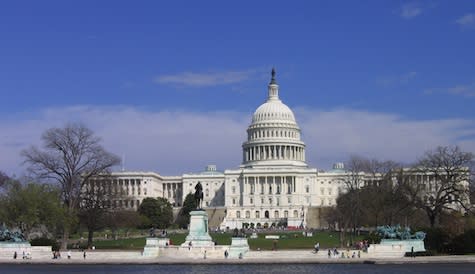Q&A: AAFA President on the Year Ahead for Apparel

It’s changing times for the apparel industry—new consumers are changing their demands on retail, stores are suffering at the hands of both that modern consumer and increasing interest in e-commerce, and trade could soon be influx with upcoming presidential elections in the U.S., and still-pending trade agreements.
Rick Helfenbein, the American Apparel and Footwear Association’s (AAFA) new president and CEO, steps into the role amid a shifting market. Here’s his insight on how things will shape up in the apparel industry over the next year and the role AAFA will play.
More from Sourcing Journal
AAFA Urges Cambodian Government to Crack Down on 'Blood Bricks' Trade
US Lawmakers Demand Living Wages for Bangladeshi Garment Workers
SJ: What are your plans for AAFA this year? What do you hope to achieve?
RH: Following the new AAFA Strategic Plan we plan to be out front in three very specific areas: brand protection (intellectual property rights), trade and supply chain. We will also be improving and advancing our methods of communication. AAFA will have a new weekly newsletter and (longer term) a new website. In June, our e-mail address will change to reflect a more global positioning of the AAFA brand. Since our office moved closer to the Capitol Building, and with the announcement of the new strategic plan, our membership rolls are growing, for which we are extremely grateful.
We will continue to fight to protect our members’ brands worldwide. This includes engagement with U.S. and foreign governments, and with other appropriate stakeholders. Alibaba remains a major concern to our members with regard to intellectual property, and we will continue to focus on that important issue until there is a simple and transparent process for permanent takedowns of infringing products.
SJ: What’s going on with respect to trade?
RH: Trade is always an ongoing battle, especially as we now have to deal with self-propelled antagonism from presidential candidates. We fully support all GSP and Miscellaneous Tariff Bill (MTB) activity. We are pushing hard to get the Trans-Pacific Partnership (TPP) approved and will continue to engage on the Transatlantic Trade and Investment Partnership (TTIP), as negotiations progress. A big focus this year is helping our members to engage in Africa using the African Growth and Opportunity Act (AGOA), and finding ways to make sure the Western Hemisphere stays competitive.
SJ: There are contradicting viewpoints on TPP. Could you comment?
RH: AAFA strongly supports early approval and implementation of the TPP. Even a one-year delay in the implementation of TPP would cost our industry over $1 billion in lost duty-savings. TPP gives our members access to new markets, new suppliers and new opportunities. It will directly support job creation and add to product value-add through innovation. There is nothing truly contradictory about TPP. It has, unfortunately, become a target for politicians and fodder for angry voters. No matter what happens, the U.S.A. remains only 5 percent of the world’s population. If we do not trade, we cannot grow. If we do not make a forward move, someone else will.
SJ: The third part of your strategic plan is supply chain. What are you doing there?
RH: AAFA has long been a leader in many supply chain disciplines, such as product safety, chemical management and social responsibility. We want to take our expertise and leadership in this area to the next level with revised offerings and reconfigured events. Moreover, with increasing transparency and traceability demands on these supply chains, members are increasingly looking to us to help them navigate regulatory and business challenges. Members always look for value, and if we can help cut costs by eliminating waste from their supply chains, or making those supply chains smarter, this becomes a win-win for all parties.
SJ: You recently opened AAFA’s 14th annual Sourcing Conference, discussing the seismic changes in global sourcing. Could you expand?
RH: Quite simply, speed to market and price remain paramount. If a company has the luxury of longer lead time, then they can source further out in places like Pakistan or Bangladesh, or Sub-Saharan Africa. If fast fashion is the key driver, then China or Vietnam become the likely destinations, simply because of quality and speed. I would also note that Made in the U.S.A. and near-shoring in the Western Hemisphere come into play as well. There is a big push for duty-free, and when TPP happens there, we will likely see more of a switch from China into Vietnam.
SJ: As you come from manufacturing, what is the outlook from overseas?
RH: If you have ever lived on an island, your image of the world comes from whatever news one reads. Our friends in Asia are truly disturbed by the tenor of the U.S. political news front. From their spectrum, it looks like the U.S. would enter into an isolation phase and their business will be cut. In addition, bankruptcies and store closings are making everyone nervous. The current tendency is to look inward toward the China retail landscape, and to alter their means and planning for business survival. As much as the U.S. has been in the buyer’s seat for years, one can now easily say that China has a population of 1.35 billion people, whereas the U.S. has only 0.32 billion. Maybe the opportunity is elsewhere?
SJ: What do the next 60 days look like?
RH: Busy. AAFA is hosting the 38th annual, American Image Awards on May 24 in NYC. With an outstanding slate of honorees who have made significant contributions to our industry, we encourage everyone to join us for this very special evening. Beyond that important singular event, we have numerous upcoming sessions in New York, Washington, and around the country, as we continue to build value for AAFA members in our core areas.
I am also proud of the formation of the AAFA Footwear Action Committee. This new Committee will enable AAFA to further the footwear services we already provide our members. The member-led AAFA Footwear Action Committee will focus on three areas: 1) producing footwear-specific products/tools; 2) driving footwear-focused policy, and 3) creating a forum for discussion and feedback on footwear issues. The Committee is already hard at work on new initiatives for footwear.
SJ: Are there any updates from the Hill that the apparel and footwear industry should know about?
RH: Capitol Hill is doing a great job cleaning up what was left by the last (113th) Congress. Trade bills have been moving forward. GSP and (recently) the Miscellaneous Tariff Bill (MTB), AGOA and Trade Promotion Authority (TPA) have been renewed. TPP has also received much attention. By summer recess, with the pending election, it will be cold up on Capitol Hill and the lights will be dim. Expect all eyes to be on lame duck, but also remember that it’s impossible to pack 20 lbs. into a 10-lb. sack. The bigger problem in the world of trade will be who has control of the Houses of Congress (and, of course, who occupies the White House). That will determine the course of power in terms of America’s trade.
Rick Helfenbein is president & CEO of the American Apparel & Footwear Association and is a strong advocate for a robust U.S. trade agenda and for “Made in USA.” He lectures frequently on the subjects of politics and international trade. Follow him on Twitter @rhelfen.


